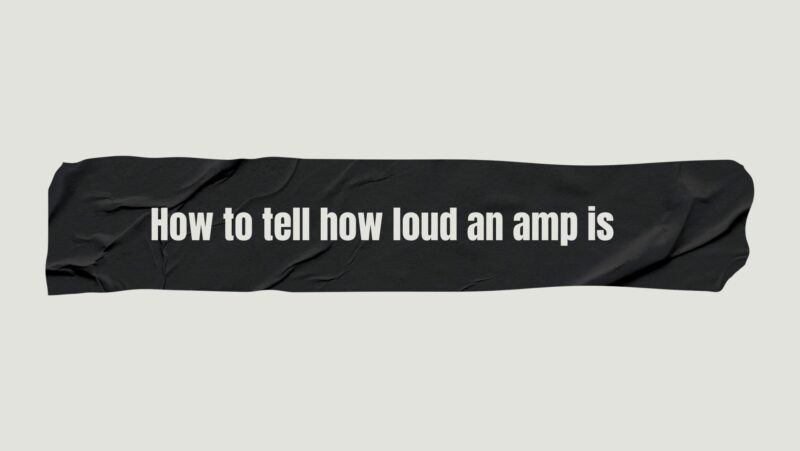The quest to gauge the loudness of an amplifier is a pursuit that resonates with audiophiles, musicians, and enthusiasts alike. Amplifier loudness is a multidimensional concept that involves understanding technical specifications, practical considerations, and the subjective nature of human hearing. This article dives deep into the intricacies of determining amplifier loudness, presenting a comprehensive guide that empowers individuals to make informed decisions about their audio setups.
Understanding Amplifier Loudness
Amplifier loudness is not solely determined by wattage; it’s a culmination of various factors, including power output, speaker efficiency, room acoustics, and the sensitivity of the listener’s ears. To accurately assess how loud an amplifier is, it’s crucial to examine a combination of quantitative data and qualitative listening experiences.
Evaluating Amplifier Specifications
- Wattage: Wattage is a foundational aspect, representing the power output of an amplifier. However, it’s important to note that doubling the wattage doesn’t result in a perceived doubling of loudness. The relationship between wattage and perceived loudness follows a logarithmic scale, meaning a significant increase in wattage is needed to achieve a noticeable increase in volume.
- Sensitivity: Speaker sensitivity, measured in decibels (dB) at 1 meter distance with 1 watt of power, is a critical factor. More sensitive speakers require less power to produce a given volume. A speaker with a sensitivity of 90 dB is significantly louder than one with 85 dB sensitivity when driven by the same wattage.
Quantitative Tools for Measurement
- Decibel (dB): The decibel is a unit used to measure sound intensity. It’s a logarithmic scale that measures the ratio between two sound levels. A 3 dB increase represents a doubling of sound intensity, while a 10 dB increase is perceived as roughly twice as loud to the human ear.
- SPL Meter: A Sound Pressure Level (SPL) meter is a device that measures sound intensity in decibels. It can help quantify the loudness of an amplifier’s output by measuring the sound pressure level at a specific distance from the speakers.
Subjective Listening Evaluation
- Use Reference Tracks: Play familiar reference tracks across various genres and assess how clear and impactful the sound is. Reference tracks help you gauge the amplifier’s ability to handle different frequencies and dynamic ranges.
- Dynamic Content: Listen to tracks with varying levels of complexity, such as orchestral pieces or songs with abrupt dynamic shifts. An amplifier’s performance during soft and loud passages provides insight into its dynamic capabilities.
- Listen for Distortion: As you increase the volume, pay attention to any distortion, clipping, or harshness in the sound. This indicates that the amplifier might be pushed beyond its optimal limits.
Factors Affecting Perceived Loudness
- Room Acoustics: The characteristics of the room significantly impact how loud an amplifier sounds. A small reflective room can make an amplifier seem louder, while a larger, acoustically treated room might require more power to achieve the same apparent loudness.
- Speaker Impedance: The impedance of the speakers affects the power the amplifier delivers. Match the amplifier’s impedance output with the speakers for optimal performance.
Comparative Listening Tests
- A/B Testing: Compare the amplifier in question with another known amplifier using the same speakers and content. Switch between the amplifiers to discern any differences in loudness, clarity, and overall sound quality.
- Blind Testing: Blind testing removes bias by concealing the identity of the amplifiers being tested. This approach ensures that you’re evaluating loudness purely based on perception, not preconceived notions.
Real-World Scenarios
- Home Listening: In a home environment, an amplifier that can produce around 50-100 watts should suffice for most listening scenarios. However, other factors such as room size and speaker sensitivity must be considered.
- Live Performances: In live music settings, the size of the venue, the type of music, and the audience’s expectations influence the required amplifier power. Smaller venues might do well with 100 watts, while larger concerts could demand significantly more power.
Conclusion
Determining how loud an amplifier is involves a blend of objective measurement and subjective evaluation. While specifications such as wattage and sensitivity provide essential information, the actual perceived loudness varies based on factors like room acoustics and the listener’s ears. Incorporating quantitative tools like SPL meters with qualitative listening tests empowers enthusiasts to accurately assess an amplifier’s loudness. Ultimately, the journey to understanding amplifier loudness is an exploration of technical knowledge and auditory perception, resulting in an enhanced appreciation of sound quality and optimal listening experiences.


